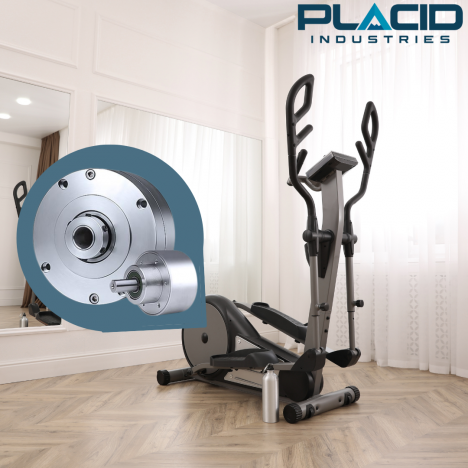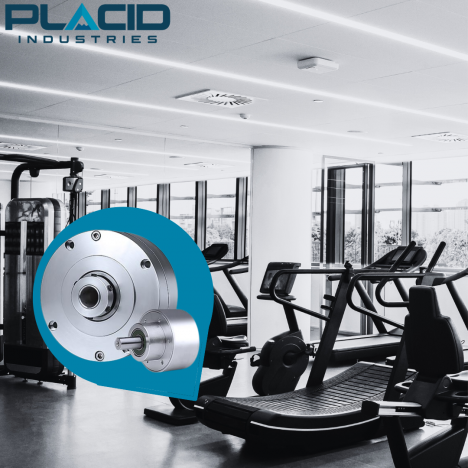Magnetic Particle Brakes for Resistance-Based Fitness Equipment
Fitness equipment manufacturers must ensure their products meet consumer expectations. This means design is just as important as function. For manufacturers who develop resistance-based fitness equipment, selecting the best technology for your system can be a challenging task. Placid Industries works closely with leaders in the Fitness Industry and provides them with superior motion control products for their newest developments. Placid Industries Magnetic Particle Brakes are often used to provide extremely precise resistance in fitness equipment. Our team of technical experts is readily available to identify the best product for your application.

How do magnetic particle brakes work?
Magnetic Particle Brakes utilize a proprietary blend of fine, dry, stainless steel powder to generate torque or resistance. Review the cross-section of the magnetic particle brake. As you can see, the output shaft and disc do not come into contact with the brake’s body. Instead, the output shaft and disc contact the free-flowing magnetic powder. When this powder is energized, its particles form chains along the magnetic field lines. The more current that is applied to a magnetic particle brake, the stronger this connection becomes. Because of this, torque, or in this case, resistance, is proportional to the magnetic field strength, and therefore to the applied DC input current.
Elliptical Machines
Magnetic Particle Brakes are mounted onto the main rotary shaft of the elliptical machine. This shaft is responsible for controlling the running motion of the user. When a user wishes to increase the resistance on the elliptical machine, the supplied current increases, effectively increasing the resistance the magnetic particle clutch produces. 
Treadmills
Magnetic Particle Brakes are used for tension control and resistance control in treadmills. As users increase the resistance in self-powered or manual treadmills, the supplied current to the magnetic particle brake is increased. The magnetic particle brakes are also used to maintain proper belt tension.

Stationary Bikes
Similarly to elliptical machines, stationary bikes utilize magnetic particle brakes for precise resistance control. The magnetic particle brakes are mounted on the central "crank" shaft and provide resistance for users to “ride” through. The higher the supplied current to the magnetic particle brake, the higher the level of resistance. 
Intelligent Exercise & Rehabilitation Equipment
This type of fitness and rehabilitation equipment is used heavily in the professional sports industry. This type of equipment utilizes the precise resistance from Magnetic Particle Brakes to test athletes’ range of motion, perfect their movement, and improve their overall performance. Manufacturers of this type of equipment have proprietary systems that focus on a specific type of training. No matter the type of training, Magnetic Particle Brakes provide trustworthy, repeatable, and precise resistance for fitness equipment. Have a current design that requires this level of resistance control? Don’t hesitate, contact our technical staff today!


Why Work with Placid Industries?
Placid Industries has over 50 years of experience manufacturing Magnetic Particle Brakes for resistance-based equipment. We have worked with many manufacturers in the fitness industry, from small start-ups to large multinational corporations. No matter the size of your project or the complexity of your system, Placid Industries has the technical expertise to develop a motion control system tailored to your application. Our customers trust us to provide unparalleled customer service, superior product quality, and a quick turnaround time. Is the lead time too long for your current supplier? We typically ship our orders within 48 hours of receiving them. Have questions? Want to speak with an engineer about your new project? Please feel free to fill out a general inquiry form, or contact us directly today!
